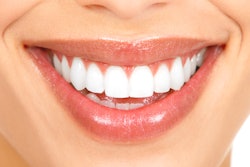You couldn't attract a mate without an inviting smile. Your employment prospects would be rather limited too. Maybe that's why Pearl Jam, Charlie Chaplin, and Laura Nyro all wrote songs called "Smile."
But what makes a good smile? In the September 2007 issue of Angle Orthodontist, Pieter Van der Geld and his colleagues at Radboud and Tilberg universities in the Netherlands, conclude that people are most satisfied when their smiles show 2 mm to 4 mm of gum.
The study is one of a flurry in recent years that have attempted to establish industry standards for good smiles. Traditionally dentists relied on the Golden Ratio -- a set of mathematical proportions that date back to the Egyptian pyramids. But some researchers have questioned whether these proportions have any connection to the way real people react to smiles.
Functionally superior dental work doesn't necessarily result in an attractive smile, either. "Many movie stars have an attractive smile that is not technically perfect from a dental perspective," Van der Geld and his colleagues wrote. "However, when the smile fits in the face, the imperfections are not always regarded as disturbing."
To blow away the fog of confusion on this subject, researchers in previous studies have asked a random selection of people to rate computer-generated smiling faces; other studies have gauged the reaction to smiles of celebrities. Still others have compared what the general public thinks to what dentists and orthodontists think -- and found some notable differences.
A July 2006 article for Angle Orthodontist by Sanjay M. Parekh et al., was fairly typical in concluding that good smiles had big arcs. Much weaker evidence suggests that a gap appearing among the posterior teeth (negative space in the buccal corridor) makes a smile less attractive.
Van der Geld and his colleagues took a different tack. What patients think of their own smiles is probably more important than what other people think, so the Dutch researchers asked subjects to rate their own smiles.
They took pictures of 122 smiling men from a Dutch air force base, then gave each man his photo and asked him to rate the attractiveness of the smile -- and his satisfaction with it -- according to the size, color, and position of the teeth and how much of the teeth and gums was visible.
Researchers found that what individuals thought was most attractive didn't necessarily give them the most satisfaction.
The size and visibility of teeth, and upper lip position were the most important predictive variables for smile attractiveness. That fit with previous research suggesting women like to see expressive smiles in men. On the other hand, tooth color and visibility of gums correlated with the men's own satisfaction in their smiles.
To get further insights, Van der Geld and his colleagues administered the Dutch Personality Index questionnaire to each of the men. They found that the less a man's gums showed the more likely he was to be neurotic. The more his gums showed, the more likely he was to have high self-esteem. Men with more visible teeth were more likely to feel dominant.
The findings confirmed what the authors expected: that personality traits are related to smile attributes. The kind of smile a person can make apparently helps to shape that person's self-image.
The lesson for dentists, orthodontists, and other engineers of the smile? Take into consideration the profound effects that your work may have on the way patients see themselves.
Sources:
Angle Orthodontist: 77: 759-765, Sept. 2007
Angle Orthodontist: 76(4): 557-63, July 2007



















